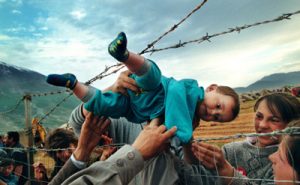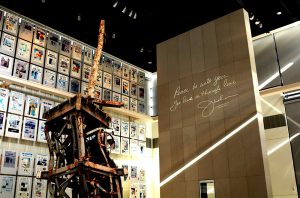
The first image I viewed from the Newseum’s Pulitzer Prize photo gallery is called “Kosovo Refugees”. In 2000, photographer Carol Guzy spent time at a refugee camp in Albania during the Kosovo crisis. The award-winning photo depicts a young boy being passed through a barbed wire fence at the border. I was drawn to this photo because the extraordinary use of visual elements allowed me to connect to the child struggling between the fence. In my opinion, “Kosovo Refugees” is among the most strikingly emotional photographs mounted in the Newseum. No doubt, Guzy’s photograph is effective in evoking emotion. As I gazed into the child’s eyes filled with fear, my heart broke. The frantic environment captured by the photographer delivers the underlying message of conflict and desperation. I felt sympathetic towards the two-year-old child who seems so panicked… it’s hard to imagine that thousands of ethnic Albanians were forced to flee their homes in Kosovo.

The second image I viewed from the Newseum’s Pulitzer Prize photo gallery is called “Chiapas Racers”. In 2003, photographer Don Bartletti documented the desperate migration of Central American children searching for parents who had immigrated to the United States. Amazingly, he decided to ride atop of a train with the children who were in search of their parents. The award-winning photo portrays a young boy and girl who are on a horse racing alongside the train in the jungle. I was drawn to this photo because these children were smiling and laughing, unlike the other children Bartletti had photographed. Although they were risking their lives in search of their parents, they were still thoroughly enjoying themselves. The expressions on the children’s faces made it seem as if they didn’t have the slightest idea that they were on a treacherous journey. Therefore, I find it significant that it captures the emotional differences between the issues occurring and the individuals in the photograph. Not only is the image unique and special in its own nature, but it also conveys a powerful message about living life to the fullest. I felt joyful after viewing this photo. Most photos that have won the Pulitzer Prize tend to directly demonstrate the emotional reactions to sad events or issues, whereas “Chiapas Racers” does the opposite.
Truthfully, I don’t think I would be able to separate my job from being human. Some of the struggles of being a photojournalist include witnessing these heartbreaking events with their own eyes. Despite the fact that they are capturing a historical moment that others will be able to learn from, it must be extremely difficult for them to decide between taking a photo or saving someone’s life. Sometimes, photojournalists can’t help given the circumstances. It is painful to imagine how much guilt weighs on them and how they have no choice but to live with that regret forever after.

My favorite exhibit was the 9/11 Gallery & Film because it has remarkable first-person accounts from journalists who covered the story. My favorite artifact in it was the 360-foot antenna mast that toppled from the World Trade Center’s North Tower when the building collapsed. The antenna served most of New York City’s television stations. This exhibit fits in with the rest of the Newseum because records of the tragic yet historical event allow people to get a deeper understanding of the past.
